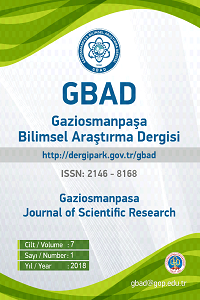Ortaokul Öğrencilerinin “Yardımseverlik” Değeri İle İlgili Metefor Algıları
Bu çalışmanın amacı ortaokul 5, 6 ve 7. sınıf öğrencilerinin “Yardımseverlik” değeri ile ilgili algılarının metaforlar yoluyla belirlenmesidir. Araştırmada nitel araştırma yöntemlerinden olgubilim deseni kullanılmıştır. Çalışma grubunu 2012-2013 eğitim öğretim yılında Aksaray ili Cihanbeyli ilçesi Faik Türkmen ortaokulunda öğrenim gören 5,6 ve 7. sınıf toplam 179 öğrenci oluşturmaktadır. Araştırmanın verileri boşluk doldurmayı gerektiren ve tek sorudan ibaret olan bir formla toplanmıştır. Verilerin analizinde betimsel analiz tekniği kullanılmıştır. 179 öğrenci 101 metafor oluşturmuştur. 5. sınıflar 43, 6. sınıflar 24 ve 7. sınıflar 33 metafor oluşturmuşlardır. Geliştirilen bu metaforlar “duygu olarak yardımseverlik, aile ve sosyal çevre olarak yardımseverlik, doğal çevre olarak yardımseverlik, nesne olarak yardımseverlik, görülmeyen varlık olarak yardımseverlik gibi beş temel kategori altında toplanmıştır. Araştırmada öğrencilerin gelişimsel düzeylerine uygun olarak metafor geliştirdikleri ve “Yardımseverlik” değerini önemsedikleri sonucuna ulaşılmıştır.
Anahtar Kelimeler:
Metafor, değer, yardımseverlik.
Secondary School Students of “Helpfulness” Value Related to The Perception of Metaphor
The aim of this study is determining the 5, 6, and 7 grade students’ percetions by the help of metaphors. The reseach was carried out with qualitative research methods and has been patterned with factualism. The study group consists of 179 student which have been receiving education from 5,6, and 7 grades of Aksaray Faik Türkmen Secondary School. The data of this research was collected with gap filling form that consist of one question. Descriptive analysis method is used to analysis the data. 101 metaphor was produced by 179 students. 5 grade students are produced 43 metaphor, 6 grades 24 and 7 grades 33. This metaphors are collected in four basic categories which are named; “helfulness as an emotion, helfulness as family and social environment, helfulness as natural environment, helfulness as an object and helfulness as an unseeable creature. In the light of the results, students’ metaphors are appropriate for their developmental levels and they attaches importance to the worth of “helpfullness”.
Keywords:
Metaphor, worth, helpfullness,
- ISSN: 2146-8168
- Yayın Aralığı: Yılda 3 Sayı
- Başlangıç: 2012
- Yayıncı: Tokat Gaziosmanpaşa Üniversitesi
Sayıdaki Diğer Makaleler
Manisa Spil Dağı Milli Parkı Kırsal Turizm Potansiyelinin Belirlenmesi
Çift Yanlı Doğru Akım Lineer Motor Tasarımı
Recep DEMİRCİ, Mehmet TANER TUNCAY
Robertson-Walker Uzay-zaman Modellerinde Lightlike Hiperyüzeylerin Simetri Koşulları
Ortaokul Öğrencilerinin “Yardımseverlik” Değeri İle İlgili Metefor Algıları
Ömer Faruk SÖNMEZ, Nihan AKINCAN
Tarihi Niksar Kulak Kümbetinin Deprem Altındaki Sismik Davranışının Değerlendirilmesi
Derya AĞCADAĞ, Nuray KIZILASLAN, Hasan Gökhan DOĞAN, Emine Burcu CEBECİ
TRA I Bölgesindeki Çiftçilerin Riske Karşı Tutumları Açısından Sosyo-Ekonomik Özellikleri
